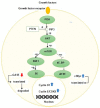Tumor Suppressive Effects of GAS5 in Cancer Cells
- PMID: 35736636
- PMCID: PMC9228804
- DOI: 10.3390/ncrna8030039
Tumor Suppressive Effects of GAS5 in Cancer Cells
Abstract
In recent years, long non-coding RNAs (lncRNAs) have been shown to play important regulatory roles in cellular processes. Growth arrests specific transcript 5 (GAS5) is a lncRNA that is highly expressed during the cell cycle arrest phase but is downregulated in actively growing cells. Growth arrests specific transcript 5 was discovered to be downregulated in several cancers, primarily solid tumors, and it is known as a tumor suppressor gene that regulates cell proliferation, invasion, migration, and apoptosis via multiple molecular mechanisms. Furthermore, GAS5 polymorphism was found to affect GAS5 expression and functionality in a cell-specific manner. This review article focuses on GAS5's tumor-suppressive effects in regulating oncogenic signaling pathways, cell cycle, apoptosis, tumor-associated genes, and treatment-resistant cells. We also discussed genetic polymorphisms of GAS5 and their association with cancer susceptibility.
Keywords: GAS5; growth-arrest specific transcript 5; lncRNA; polymorphism; tumor suppressor.
Conflict of interest statement
The authors declare no conflict of interest.
Figures






Similar articles
-
The role of long non-coding RNA GAS5 in cancers.Cancer Manag Res. 2019 Apr 8;11:2729-2737. doi: 10.2147/CMAR.S189052. eCollection 2019. Cancer Manag Res. 2019. PMID: 31114330 Free PMC article.
-
Upregulation of Long Noncoding RNA_GAS5 Suppresses Cell Proliferation and Metastasis in Laryngeal Cancer via Regulating PI3K/AKT/mTOR Signaling Pathway.Technol Cancer Res Treat. 2021 Jan-Dec;20:1533033821990074. doi: 10.1177/1533033821990074. Technol Cancer Res Treat. 2021. PMID: 33641529 Free PMC article.
-
Exploring GAS5's impact on prostate cancer: Recent discoveries and emerging paradigms.Pathol Res Pract. 2023 Nov;251:154851. doi: 10.1016/j.prp.2023.154851. Epub 2023 Oct 4. Pathol Res Pract. 2023. PMID: 37837861 Review.
-
The growth arrest-specific transcript 5 (GAS5): a pivotal tumor suppressor long noncoding RNA in human cancers.Tumour Biol. 2016 Feb;37(2):1437-44. doi: 10.1007/s13277-015-4521-9. Epub 2015 Dec 3. Tumour Biol. 2016. PMID: 26634743 Review.
-
Research Progress of Long Non-Coding RNA GAS5 in Malignant Tumors.Front Oncol. 2022 Jun 28;12:846497. doi: 10.3389/fonc.2022.846497. eCollection 2022. Front Oncol. 2022. PMID: 35837102 Free PMC article. Review.
Cited by
-
Long non-coding RNAs in cancer: multifaceted roles and potential targets for immunotherapy.Mol Cell Biochem. 2024 Dec;479(12):3229-3254. doi: 10.1007/s11010-024-04933-1. Epub 2024 Feb 28. Mol Cell Biochem. 2024. PMID: 38413478 Review.
-
PRELP regulated by GAS5/miR-3127-5p suppresses cisplatin resistance in oral squamous cell carcinoma.Cytotechnology. 2025 Jun;77(3):92. doi: 10.1007/s10616-025-00749-z. Epub 2025 Apr 28. Cytotechnology. 2025. PMID: 40309012
-
The role of long noncoding RNAs in therapeutic resistance in cervical cancer.Front Cell Dev Biol. 2022 Nov 9;10:1060909. doi: 10.3389/fcell.2022.1060909. eCollection 2022. Front Cell Dev Biol. 2022. PMID: 36438563 Free PMC article. Review.
-
The Biological Role and Translational Implications of the Long Non-Coding RNA GAS5 in Breast Cancer.Cancers (Basel). 2023 Jun 23;15(13):3318. doi: 10.3390/cancers15133318. Cancers (Basel). 2023. PMID: 37444428 Free PMC article. Review.
-
Cellular Epigenetic Targets and Epidrugs in Breast Cancer Therapy: Mechanisms, Challenges, and Future Perspectives.Pharmaceuticals (Basel). 2025 Feb 3;18(2):207. doi: 10.3390/ph18020207. Pharmaceuticals (Basel). 2025. PMID: 40006021 Free PMC article. Review.
References
Publication types
Grants and funding
LinkOut - more resources
Full Text Sources

